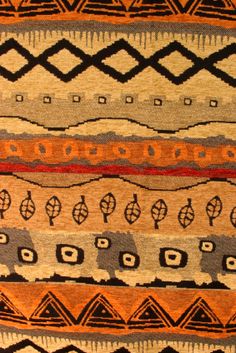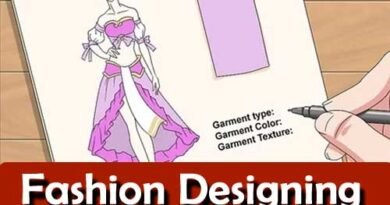Fabric Design
Fabric design is a fundamental aspect of fashion design, encompassing the creation and manipulation of textiles to achieve desired aesthetic, functional, and expressive outcomes. This class note explores the significance of fabric design in fashion, covering its historical evolution, techniques, contemporary applications, and the intersection of artistry and technology. From traditional handcrafted textiles to innovative digital prints, fabric design plays a pivotal role in defining fashion collections and reflecting cultural narratives.

1. Historical Evolution of Fabric Design
Fabric design has evolved significantly over centuries, influenced by technological advancements, cultural exchanges, and artistic movements:
- Early Innovations: Historical fabric design began with primitive techniques such as weaving, dyeing, and embroidery, dating back to ancient civilizations like Mesopotamia, Egypt, and China. These early methods laid the foundation for textile production and pattern-making.
- Medieval and Renaissance Period: During the Middle Ages and Renaissance, European textile guilds flourished, producing intricate woven fabrics, tapestries, and embroidered textiles for aristocratic patrons. Techniques like jacquard weaving and brocade became prominent.
- Industrial Revolution: The 18th and 19th centuries saw the mechanization of textile production, revolutionizing fabric design with the invention of power looms and printing presses. Mass production made textiles more accessible and affordable.
- Art Nouveau and Art Deco: In the late 19th and early 20th centuries, art movements like Art Nouveau and Art Deco influenced fabric design, emphasizing organic forms, geometric patterns, and luxurious materials.
- Modern Era: Post-World War II, fabric design diversified with the advent of synthetic fibers, digital printing technologies, and avant-garde approaches. Designers experimented with abstract motifs, minimalist aesthetics, and sustainability.
Understanding the historical evolution of fabric design provides context for appreciating its dynamic role in contemporary fashion.
2. Techniques in Fabric Design
Fabric design encompasses a range of techniques that manipulate textiles to achieve diverse textures, patterns, and finishes:
- Weaving: The interlacing of yarns on a loom to create woven fabrics with different weave structures (e.g., plain, twill, satin). Weaving allows for the incorporation of patterns and textures directly into the fabric.
- Printing: Application of colors, patterns, or designs onto fabric surfaces using techniques such as:
- Screen Printing: Stencils (screens) are used to apply layers of ink onto the fabric through a mesh screen.
- Digital Printing: Direct printing of designs onto fabric using digital files, offering high-resolution and intricate detailing.
- Block Printing: Hand-carved blocks are used to stamp patterns onto fabric using dye or pigment.
- Dyeing: Application of color to fabric fibers or surfaces through immersion, painting, or resist techniques (e.g., tie-dye, batik).
- Embroidery: Decorative stitching or embellishment of fabric using threads, yarns, beads, or sequins to create intricate patterns or designs.
- Knitting and Crochet: Interlooping yarns to create textiles with elastic properties (knitting) or using a hook to create openwork patterns (crochet).
- Felting: Agitation and compression of fibers (wool, silk) to create non-woven fabrics with unique textures and properties.
- Quilting: Stitching together multiple layers of fabric to create a padded textile, often featuring intricate patterns or motifs.

Each technique offers unique opportunities for creativity, craftsmanship, and artistic expression in fabric design.
3. Contemporary Applications of Fabric Design
In contemporary fashion, fabric design serves as a catalyst for innovation, sustainability, and cultural expression:
- High Fashion Collections: Fashion designers collaborate with textile artists and mills to create custom fabrics that reflect the designer’s aesthetic vision and collection themes. Fabrics may feature bespoke prints, textures, or embellishments.
- Ready-to-Wear Fashion: Mass-market fashion brands utilize digital printing and advanced textile technologies to produce affordable yet stylish fabrics with on-trend prints and patterns.
- Textile Art Installations: Textile artists and designers create large-scale installations and exhibitions using fabric as a medium for artistic expression and storytelling.
- Sustainable Practices: Designers embrace eco-friendly fabrics (organic cotton, bamboo, recycled polyester) and low-impact dyeing techniques to minimize environmental footprint and promote ethical fashion practices.
- Cultural Revival: Indigenous and traditional textile techniques are revived and incorporated into contemporary designs, preserving cultural heritage and supporting artisan communities.
- Technological Integration: Advancements in digital design software, 3D printing, and smart textiles enable designers to push boundaries in texture, functionality, and interactive design elements.
The versatility of fabric design allows designers to explore new avenues in fashion while honoring craftsmanship and cultural diversity.
4. Designing with Fabric in Mind
Effective fabric design involves strategic planning and consideration of various elements to achieve cohesive and impactful outcomes:
- Material Selection: Choose fabrics based on their aesthetic properties (texture, drape, sheen), functional requirements (comfort, durability), and sustainability credentials.
- Pattern and Print Development: Develop original patterns, motifs, or digital prints that resonate with the collection’s theme or narrative. Consider scale, color palette, and repeat patterns for visual coherence.
- Texture and Embellishment: Integrate textures (weaving patterns, embroidery stitches) and embellishments (beads, sequins) to add dimension and tactile interest to fabric surfaces.
- Color Theory: Apply principles of color theory (hue, saturation, value) to select colors that evoke desired emotions, complement skin tones, or convey brand identity.
- Collaboration and Communication: Collaborate with textile suppliers, printers, and artisans to translate design concepts into tangible fabrics. Effective communication ensures alignment with production capabilities and quality standards.
- Prototype Development: Create fabric swatches or samples to test design concepts, fabric performance, and aesthetic appeal before full-scale production.
Designing with fabric in mind requires attention to detail, technical proficiency, and creative vision to bring fashion concepts to life.

5. Innovations in Fabric Design
Recent innovations in fabric design showcase the industry’s evolution towards sustainability, technology integration, and creative experimentation:
- Smart Textiles: Fabrics embedded with sensors, LEDs, or conductive threads that respond to environmental stimuli (e.g., temperature, movement).
- Biodegradable Fabrics: Development of textiles made from natural fibers (e.g., hemp, organic cotton) or bio-based materials (e.g., algae, pineapple leaf fibers) that decompose safely at end-of-life.
- Virtual Prototyping: Use of digital simulation and 3D modeling software to visualize fabric designs, patterns, and textures before physical production.
- Augmented Reality (AR) in Retail: AR applications that allow consumers to virtually try on garments and visualize fabric patterns or customization options in real-time.
- Collaborative Platforms: Online platforms that connect designers with textile suppliers, printers, and artisans globally, facilitating sustainable sourcing and production practices.
These innovations drive creativity, efficiency, and sustainability in fabric design, shaping the future of fashion.
6. Cultural Significance of Fabric Design
Fabric design holds cultural significance as a means of preserving heritage, identity, and storytelling through textiles:
- Traditional Textile Arts: Indigenous communities worldwide maintain textile traditions through weaving, dyeing, and embroidery techniques that reflect local customs, beliefs, and histories.
- Global Influences: Cross-cultural exchanges in fabric design contribute to diverse fashion aesthetics and promote cultural understanding and appreciation.
- Symbolism and Rituals: Fabrics often carry symbolic meanings related to rites of passage, ceremonial events, or social status within communities.
- Revitalization Efforts: Cultural institutions, designers, and advocates collaborate to revive endangered textile practices, support artisan livelihoods, and safeguard intangible cultural heritage.
By honoring cultural narratives and traditions, fabric design enriches fashion with depth, diversity, and respect for global heritage.

7. Ethical Considerations and Sustainability
Incorporating ethical practices and sustainability principles into fabric design fosters responsible production and consumer choices:
- Supply Chain Transparency: Traceability of raw materials, production processes, and labor conditions ensures ethical sourcing and fair trade practices.
- Circular Economy: Embrace recycling, upcycling, and closed-loop manufacturing systems to minimize waste and extend the lifecycle of textiles.
- Reduced Environmental Impact: Adopt eco-friendly fabrics, low-impact dyeing techniques, and water-saving practices to mitigate ecological footprint.
- Social Responsibility: Support artisan communities, promote gender equality, and uphold labor rights throughout the textile supply chain.
- Consumer Education: Raise awareness among consumers about the environmental and social impact of fabric choices, encouraging informed purchasing decisions.
By integrating ethical considerations into fabric design, fashion designers contribute to a sustainable industry that values people, planet, and prosperity.
Conclusion
Fabric design is an integral component of fashion design, embodying creativity, cultural heritage, and technological innovation. From ancient weaving techniques to modern digital prints, fabric design shapes fashion collections, enhances visual storytelling, and reflects societal values. By exploring historical evolution, techniques, contemporary applications, design strategies, innovations, cultural significance, and ethical practices, fashion designers can harness the transformative power of fabric design to create meaningful, sustainable, and aesthetically compelling garments.
As the fashion industry evolves, fabric design remains at the forefront of innovation and creativity, driving positive change towards a more inclusive, responsible, and culturally rich global fashion landscape.
